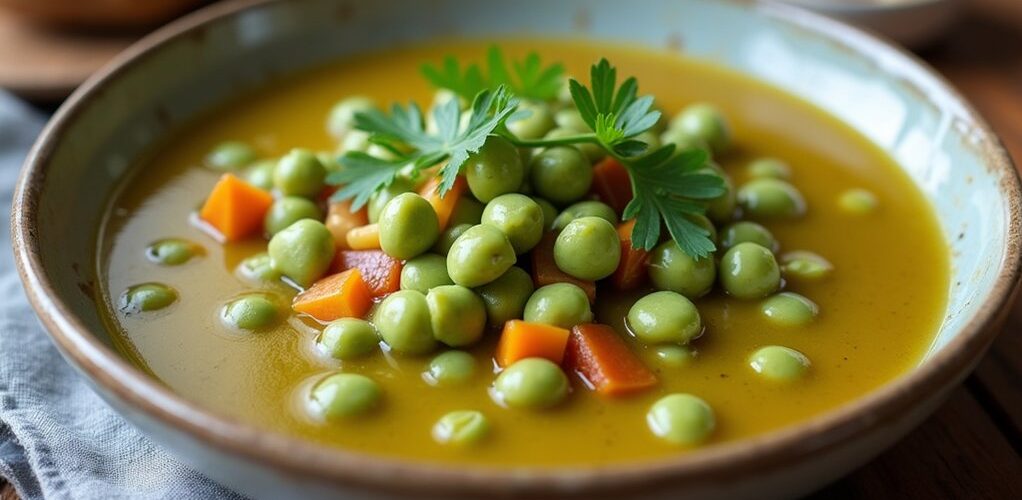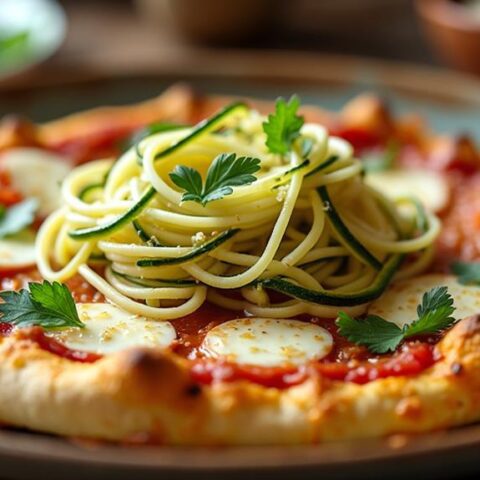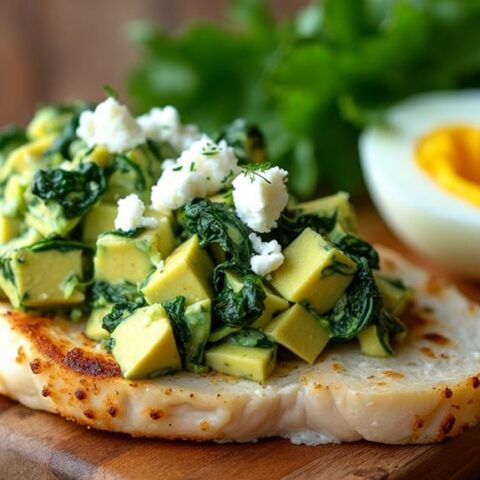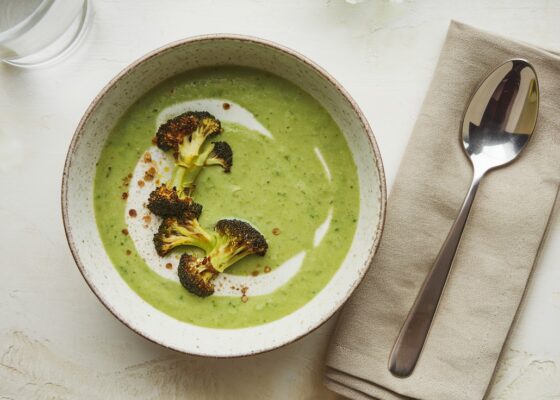
Split pea soup contains moderate carbohydrates, with approximately 19.9g of net carbs per cup serving, making it a consideration for those following low-carb diets. While the fiber content helps moderate blood sugar impact, portion control remains essential. The soup can be modified for lower carb content by reducing pea quantity and incorporating low-carb vegetables like spinach or zucchini. Understanding recipe modifications and nutritional components allows for better dietary management while enjoying this nutritious dish.
Key Takeaways
- Traditional split pea soup contains 19.9g carbohydrates per 100g serving, making it moderately high in carbs for low-carb diets.
- The fiber content in split peas helps moderate blood sugar impact, but portion control remains essential for carb management.
- You can reduce carbs by using fewer split peas and adding low-carb vegetables like spinach or zucchini instead.
- Homemade versions allow better control over ingredients, avoiding hidden sugars and high-carb additives found in commercial soups.
- Adding proteins and healthy fats while limiting starchy ingredients can make split pea soup more suitable for low-carb diets.
Understanding Net Carbs in Split Pea Soup
When evaluating split pea soup's compatibility with a low-carb diet, understanding net carbs becomes essential for making informed dietary decisions.
Split pea soup contains approximately 19.9g of carbohydrates per 100g of cooked dried peas, but calculating net carbs requires subtracting the fiber content from this total.
The net carbs in split pea soup can vary greatly based on additional ingredients commonly used in recipes.
Different recipes and ingredients can significantly impact the net carb count of your homemade split pea soup.
Vegetables like onions and carrots contribute extra carbohydrates to the final dish. For those monitoring their carbohydrate intake, it's important to take into account these additional ingredients when calculating the overall net carb content.
Blood glucose testing after consumption can help individuals determine their personal response to the soup, while portion control and ingredient modifications can help reduce the total carbohydrate impact.
Key Nutritional Benefits of Split Peas
Split peas stand out as a nutritional powerhouse, offering substantial amounts of protein and fiber, with approximately 25g of protein and 8g of fiber per 100g serving.
The impressive vitamin content includes various B vitamins that support energy metabolism and nerve function, while essential minerals like iron and potassium contribute to overall health maintenance.
Their nutrient density makes split peas an excellent addition to any diet, particularly for those seeking plant-based protein sources or looking to enhance their mineral intake through whole food options.
Protein and Fiber Content
The nutritional powerhouse of split peas delivers an impressive combination of protein and fiber content, making them a standout choice for health-conscious individuals.
With approximately 25 grams of protein per 100 grams, split peas provide substantial muscle-supporting nutrients while delivering 8 grams of dietary fiber, which aids digestive health and blood sugar regulation.
This protein-fiber duo creates a synergistic effect that supports multiple aspects of health and wellness.
The high fiber content promotes satiety, helping with weight management by reducing overall calorie intake, while the protein guarantees sustained energy throughout the day.
For those monitoring blood sugar levels, split peas' low glycemic index makes them an excellent choice, as they provide steady, sustained energy without causing significant blood sugar fluctuations.
Essential Vitamins Present
Nutritional excellence shines through the impressive array of essential vitamins found in split peas, making them a valuable addition to any balanced diet.
When consumed as split pea soup, these legumes deliver a concentrated dose of vitamin B, which supports peak brain function and helps regulate metabolism. The presence of vitamin K contributes considerably to blood clotting mechanisms and maintains bone strength, while folate proves particularly beneficial for pregnant women by supporting cell division and DNA formation.
Split peas also pack a powerful antioxidant punch through their vitamin C content, helping to strengthen immune function and protect cells from oxidative damage.
These essential vitamins work synergistically with the legume's high fiber content to promote digestive health and maintain healthy cholesterol levels.
Mineral-Rich Food Source
Mineral abundance characterizes these versatile legumes, making them a powerhouse of essential nutrients that support overall health and wellness.
Split peas deliver significant amounts of iron, an essential mineral responsible for transporting oxygen throughout the bloodstream, ensuring optimal cellular function and energy production.
The impressive mineral profile of split peas extends to their potassium content, which plays an important role in maintaining healthy blood pressure levels and supporting proper cardiovascular function.
Additionally, these nutrient-dense legumes contain essential minerals that work synergistically with their other components, such as B vitamins and antioxidants, to enhance overall nutritional benefits.
When incorporated into soups or other dishes, split peas provide a concentrated source of these important minerals, contributing to a well-balanced, nutrient-rich diet.
Making Your Split Pea Soup Lower in Carbs
While traditional split pea soup contains a considerable amount of carbohydrates, several modifications can transform this classic comfort food into a more low-carb friendly dish.
To make pea soup with fewer carbs, cooks can reduce the quantity of split peas and incorporate more low-carb vegetables like spinach, zucchini, or cauliflower. Replacing high-carb ingredients such as carrots and potatoes with these alternatives considerably decreases the overall carbohydrate content.
Using homemade broth instead of store-bought versions provides better control over sodium and carb levels. Adding lean proteins enhances the soup's nutritional value while maintaining lower carbohydrate counts.
Additionally, relying on herbs and spices for flavor rather than starchy thickeners helps create a satisfying low-carb version of this traditional soup. Incorporating more healthy fats from avocados can also provide an additional source of energy while keeping the carbohydrate content low.
Impact on Blood Sugar Levels
Split pea soup presents unique considerations for blood sugar management due to its carbohydrate content of 19.9g per 100g serving. The impact on blood sugar levels varies among individuals, with some experiencing delayed glucose increases while others notice minimal effects.
The fiber content in split peas plays a beneficial role by moderating carbohydrate absorption, helping to prevent significant blood sugar spikes. This characteristic makes split pea soup a potentially suitable option for those monitoring their glucose levels, provided portions are carefully controlled.
However, healthcare providers recommend that individuals with diabetes track their blood sugar responses after consuming split pea soup to understand their personal reactions. With its relatively low glycemic index, split pea soup can fit into a diabetes-friendly meal plan when consumed mindfully.
Recipe Modifications for Keto and Low-Carb Diets
Transforming traditional split pea soup into a keto-friendly or low-carb version requires strategic ingredient substitutions and thoughtful modifications to the classic recipe. The key adjustments include replacing high-carb vegetables like carrots and onions with lower-carb alternatives, while substituting split peas with cauliflower or green beans to maintain a similar texture and consistency. For enhanced flavor and nutritional value, incorporating protein-rich ingredients such as bacon or shredded chicken proves beneficial. Using homemade broth instead of commercial options helps control hidden sugars and sodium levels. Moderate consumption of low-carb fruits, such as raspberries or strawberries, can add a refreshing twist to your meal. Careful portion control remains essential, as even modified versions contain some carbohydrates. These adaptations allow individuals following keto or low-carb diets to enjoy a comforting bowl of soup while maintaining their dietary goals.
Portion Control and Meal Planning Tips
Successful management of split pea soup portions requires careful attention to serving sizes and strategic meal planning techniques. Using measuring cups or a food scale helps track the 19.9g of carbohydrates found in each cup serving, making portion control more precise and manageable. For effective meal planning, consider preparing individual servings of split pea soup and freezing them for convenient access throughout the week. Enhance nutritional value while maintaining lower carbohydrate content by incorporating low-carb vegetables like spinach or zucchini into the soup. When planning complete meals, focus on high-quality fats such as avocados or olive oil to complement the soup and support ketosis. Reference the glycemic index to select complementary ingredients that support blood sugar management. This systematic approach to portion control and meal preparation helps individuals maintain their dietary goals while enjoying this nutritious soup option.
Frequently Asked Questions
Is Split Pea Soup Low in Carbs?
Split pea soup has a relatively high carb content, containing approximately 19.9g of carbohydrates per 100g of cooked dried peas, making it unsuitable for strict low-carbohydrate dietary plans.
Is Split Pea Soup Ok for Type 2 Diabetics?
Split pea soup can be suitable for Type 2 diabetics as part of diabetes management, thanks to its low glycemic index, high fiber content, and moderate carbohydrate levels when prepared healthfully.
How Many Carbs Are in a Bowl of Split Pea Soup?
A bowl of split pea soup typically contains 30-40g of carbohydrates, offering nutritional benefits through fiber content. The exact amount varies depending on serving size and additional ingredients used.
Can You Eat Pea Soup on a Keto Diet?
Traditional split pea soup is not recommended for keto diets due to high carbohydrate content. Keto alternatives like cauliflower-based soups offer similar comfort while maintaining strict low-carb requirements.
Conclusion
Split pea soup, while nutritious, contains moderate carbohydrate levels that require careful consideration for those following low-carb diets. Through thoughtful modifications like reducing pea quantities, incorporating more vegetables, and adjusting portion sizes, this classic comfort food can be adapted to fit various dietary needs. Understanding net carbs and glycemic impact allows individuals to make informed decisions about including split pea soup in their meal plans while maintaining their nutritional goals.










No Comments